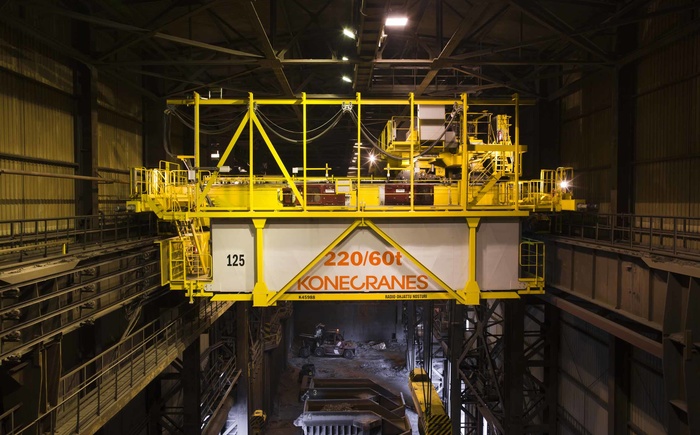A new era in steel productivity
Twenty years of proven performance by Konecranes AC-powered steel mill cranes with variable frequency drives (VFDs) has laid the groundwork for our latest generation of automated cranes. Because of modern VFD controls, travel distances, stopping distances and acceleration rates are now known quantities. Pre-programmed and consistent, they make crane automation possible.
In full automation, the crane executes an entire process–picking, transporting and delivering a load to an XY-defined location–without human assistance. Semi-automation, currently more common in steel mills, involves an operator picking the load and then pressing a button to authorize the crane to deliver it to a pre-determined destination. Pre-programmed Target Positioning or End Positioning expedites this process, saving time, labor costs and wear and tear on the machinery. In full automation, the crane executes the entire task, so additional machinery guards, covers and features designed to protect people are part of the equipment.
Which applications benefit most?
One by one, steel mill lifting applications are moving toward semi- or full automation. The benefits are undeniable. Operations can be carried out in a known time frame with fewer errors and less labor, and machinery experiences less wear and tear. Currently, full automation is working well for coil storage and intermediate processing. Scrap handling cranes, which pick scrap from an assortment of bins and deliver the mix to the furnace, also offer strong potential for full automation. Fully automated continuous casting and slab handling cranes are already in use and hot rolling mills will likely be next. In the future, it’s possible that molten metal handling will be fully automated as well.
Evolving design for better efficiency
Our cranes already include many features to help maximize safety and productivity. Movements and cycles are automatically controlled, minimizing human errors. Smart Feature technologies help improve safety, cycle time and load positioning. Konecranes Smart Features deliver major benefits when performing repetitive actions, and are particularly useful for automated cranes.
Smart Features Facilitate Semi-automation
Sway Control, Target Positioning, Protected Areas, Shock Load Prevention and Slack Rope Prevention are all Smart Features available for semi-automated cranes. Our newest additions Hook Centering, Snag Prevention and Active Sway Control offer even more sophisticated controls. The resulting smooth operation helps prevent damage to products, while fewer erratic movements help reduce wear, promoting longer equipment life.
In complicated processes such as charging, a semi-automated crane can make the operation quicker and smoother. The operator simply pushes the button for the crane to access the chosen bin. With the bucket perfectly centered over the bin, the crane lowers and grabs material. Then the operator hits the button programmed for the furnace destination, and the crane executes the pre-described path. This is especially useful for new operators.
Full automation for coil handling and processing
For coil handling, Sway Control, Target Positioning or End Positioning are key features. Combined with Compact Warehouse Management options, coils can be individually tracked and moved into and out of automated high bay storage areas prior to routing through color coating, chroming, slitting, annealing or galvanizing lines. Full automation is particularly appropriate for dip tank operations. If a manual operator adds an extra second, that time can add up to 10 total processes in a 24-hour shift. Conversely, not waiting long enough can cross-contaminate tanks, resulting in the expense of a changeover and significant product waste. Automation works best in repeatable processes where human errors that penalize the process in terms of money or time can be eliminated. While automation setup requires trial and error for each individual facility and its processes, the long-term return on investment is enormous, with significant savings on maintenance and labor.
Lifting technology that can pay for itself
Our latest generation of fully automated cranes with a Remote Operating Station, or ROS, allow new steel mills to be designed for even better safety and efficiency. Where it formerly required a team of nine operators to run three cranes over three shifts, the ROS allows two operators to run three cranes from a central location with improved working conditions. With only two cranes in a bay, one operator can handle both effectively. In addition to streamlining the labor force, the ROS saves time and promotes efficiency. Instead of climbing down from the cranes for a break, operators can access a break room positioned adjacent to the ROS.
TRUCONNECT® Remote Monitoring
TRUCONNECT Remote Monitoring uses sensors to gather crane usage data and then transmits it to our Remote Data Center where it is made available on the yourKONECRANES.com customer portal. The data can reveal anomalies, patterns and trends, allowing you to make informed maintenance decisions and reveal where operator training may be needed.
Protecting people and products
Whenever a load travels in an XY axis, there is potential for it to depart from the intended path, with possible safety or production consequences. Konecranes semi-automation, full automation and Smart Features are helping lifting equipment work faster, last longer, and help keep people out of harm’s way in modern steel mills worldwide. Konecranes has a long history of developing landmark innovations for the steel industry. Its automated crane technology is the latest innovation in that tradition.


